

How People
Treat
"Other People"
History of the 45th Surgical Hospital
Brinton Motherals Super 8 Videos
|
I Referenced My Tour 365 booklet I got on my 2nd Tour at ETS. (Tour 365 Summer 1971 Issue) The US Army Patches are Scanned From that booklet, and the Sayings are retyped from that booklet. This Information Reflects the Additudes from a different perspective, we the Soldiers who were trying to stay alive, because we were given a job to do by the President & US Congress, and the American People who elected that US Congress, and we did the best we possibly could under the conditions set by Congress, and the American People, while we were in Vietnam. My Personal Comments: When Certain People Protested the Bombing in Vietnam, and infuenced US Policy in Vietnam, they stopped bombing, and guess what, more of our US Soldiers, and civilians (South Vietnamese, women, children and babies) got killed, because the North Vietnamese without that bombing moved more amunition up through cambodia on the Ho Chi Min Trail, to kill more people. Now, who are the baby killers, Protesters that stopped the bombing were responsible for much more killing than any US Soldier ever was, if they had only known what effect they would have... There I got that off my chest.... Tour 365 Booklet Credits: Tour 365 is an authorized pulication of the United States Army, Vietnam. It is published under the supervision of the Information Officer, USARV, APO San Francisco 96375, semi-annually for distribution to soldiers returning to the United States upon completion of their tour in the Republic of Vietnam. Opinions expressed herein are not necessarily those of the Department of Defense or Department of the Army. The Following agencies are thanked for their valuable contributions to the production of Tour 365 : Military History Branch, USARV; Command Historian, USARV; U.S. Army Pictorial Center; Pacific Stars and Strips for permission to use a condensation of a review of the Cambodian offensive; and to those past and present members of the USARV Information Office staff for their editorial contributions. |
|
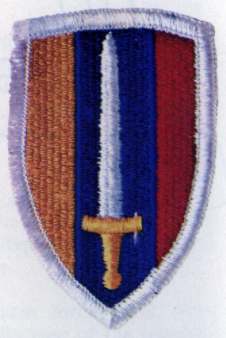 |
United States Army Vietnam (USARV Combat Patch) United States Army, Vietnam as we know it was created on July 20, 1965. But U.S. involvement in Vietnam goes back to the late 1950's with the establishment of the Military Assistance Advisory Group, Indochina. After committing itself to the defense of Southeast Asia under the Geneva Agreements and the Southeast Asia Defense Treaty, the U.S. set up a Military Assitance Advisory Group in Vietnam to provide economic, technical and military assistance. Military aid and advice was declared a state on national emergency on Oct. 18, 1961, and asked the United States for combat troops. The first complete combat units of American forces arrived in December, together with a support team, the 9th Logistical Command on Okniawa. This small team formed the nucleus from which USARV evolved. As the Army units in country increased, the U.S. Army Ryukyu Support Group, Provisional, took over logistics control of U.S. units in Vietnam. Further increases in U.S. troops necessitated that the support command be changed to U.S. Army Support Group, Vietnam. During 1965 the increase of U.S. forces was rapid, and with the arrival of the additional combat units, the U.S. Army Support Command, Vietnam, was redesignated United States Army, Vietnam. Increased roles in combat operations spurred the creation of 3 subordinate commands, I Field Force, Vietnam, II Field Force, Vietnam, and later XXIV Corps. This organization has remained basically unchanged. Under President Nixon's program of continuing Vietnamization USARV's units are currently undergoing a period of reduction in strength and redeployment back to the U.S. |
| The United States Military Assistance Command Vietnam (MACV Combat Patch) The United States Military Assistance Command, Vietnam (MACV) was established on Feb.8, 1962, as a unified command subordinate to the commander-in-chief, Pacific, MACV has the mission of assisting the Republic of Vietnam Armed Forces to maintain internal security against subversion and insurgency and to resist external aggression. With headquarters in Siagon, MACV controls all of the United States Armed Forces in Vietnam. MACV is involved in two basic activities. Its forces constantly seek to engage the enemy in combat on the ground and territorial waters of the Republic of Vietnam, to provide assitance to the constitutional government of Vietnam in building a free society capable of defending itself. |
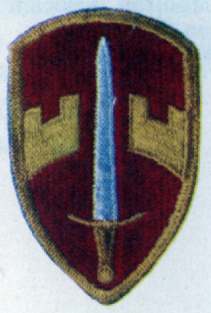 |
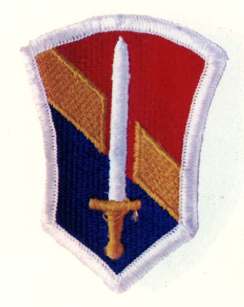 |
I Field Force, Vietnam I Field Force, Vietnam, was organized on Aug.1,1965, at Nha Trang as Task Force Alpha; its mission: to control all U.S. Army Forces in the Republic. No-names, Commanding, Commenced operations on Aug. 5, 1965, with the 173rd Airborne Brigade; 1st Brigade, 101st Airborne Division; 1st Battalion, 18th Infantry; and 2nd Battalion, 7th Marine Regiment (reinforced). November 1965, Task Force Alpha officially became Field Force, Vietnam, and in March 1966, when another field force was organized in Military Region 3, the command becam I Field Force, Vietnam. In the following years, I Field Force directed operations utilizing all or parts of the 4th Infantry Division, 101st Airborne Division, 1st Cavalry Division (Airborne), and numerous seperate combat and combat support battalions and units. In addition to renowned victories at Dak To, Ben Het, Bu Prang-Duc Lap, Cambodia, Dak Seang-Dak Poke, and Plei Djeran, combat elements of the force defeated the North Viet Namese (NVA), and Viet Cong (VC) in thousands of engagement in all 12 provinces of Military Region 2, and initiated one of the first comprehensive, U.S. Army-conducted pacification programs in The Republic of Vietnam (RVN). Today (summer of 1971), I Field Force, Vietnam, still headquartered in Nha Trang, is the senior American headquarters in Military Region 2, and continues its mission of supervising the advisory effort with the Army Republic of VietNam (ARVN), the many faceted aspects of the CORDS effort, the U.S. military operations, and coordinates the American effort with the South Vietnamese and Republic of Korea Forces in the Region. |
|
II Field Force Vietnam II Field Force, Vietnam, arrived in the Republic of Vietnam March 15, 1966, and at its height became one of the largest corps-level commands in the history of the US Army. II Field Force traces its lineage to the XXII U.S. Army Corps, formed in 1944 in the European campaign, Inactivated at the end of World War II, it was reactivated at Fort Hood, Texas, with the coming of the Vietnam confict and renamed II Field Force. II Field Force's area of responsibility is Military Region 3, the 11 provinces surrounding Siagon. At various times it had under its command the following major units of elements:1st, 9th and 25th Infantry Divisions; 101st and 82nd Airbourne Divisions; 173rd Airborne Brigade; 1st Cavalry Division (Airmobile), 11th Armored Cavalry Regiment, 12th Combat Aviation Group, 23rd and 54th Artillery Groups, and the 1st Australian Task Force and Royal Thai Army Volunteer Force. II Field Force units were responsible for the decisive defeat of enemy forces in Military Region 3 during the 1968 Tet offensive, which threatened particularly the Siagon area. But its greatest moment was the Cambodian incursion of May and June 1970 when the 25th Infantry Division, 1st Cav and 11th Armored Cav fought alongside ARVN troops of III Corps in one of the war's biggest and most successful operations. Under continuing redeployment plans, II Field Force is scheduled for reorganization at some future date into a strictly advisory role. |
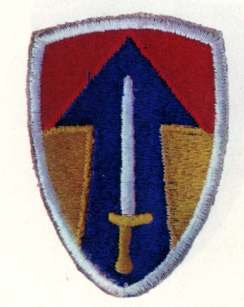 |
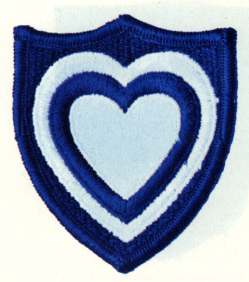 |
XXIV CORPS XXIV Corps was activated at Fort Shafter, Hawaii, on April 8, 1944. On Sept. 11 of the same year, it embarked on combat operations near Dulag on Leyte in the Philippine Islands. At that time, the 7th Infantry Division and the 96th Infantry Division were the major command elements of the Corps, later to be joined by the 77th Infantry Division, From the Philippines, XXIV Corps moved to Okinawa, and in September 1945 moved to Korea, where it remained until deactivated in January 1949. On Aug. 15, 1968, XXIV Corps was Reactivated at Phu Bai, Republic of Vietnam. It was placed under operational control of III Marine Amphibious Force (III MAF) - its brother-in-arms 24 years before in the South Pacific. On March 9, 1970, the Corps headquarters moved from Phu Bai to Camp Horn in Da Nang to become the senior U.S. military headquarters in Military Region I (MRI), replacing III MAF. The commanding general of XXIV Corps is the senior advisor to the Army of the Republic of Vietnam I Corps commander. He also is responsible for coordinating the activities of all U.S. units under XXIV Corps control are the 23rd Infantry Division (Americal), the 101st Airborne Division (Airmobile) and the 1st Brigade, 5th Infantry Division (Mechanized). |
|
1st Aviation Brigade On the frontless war in Vietnam, more than 2000 rotary and fixed-wing aircraft from the 1st Aviation Brigade give ground commanders an "extra edge" in closing with the enemy and defeating him. Never before in military history has a ground commander had such capability with which to find the enemy, conduct route and area reconnaissance, deploy infantrymen to the enemy's location, deliver sustatained firepower and supplies, control the ground battle from the air, adjust artillery and air strikes and evacuate the wounded soldiers. Since its establishment in May 1966, the 1st Aviation Brigade has consistently allowed ground commanders to keep pressure on the enemy, maintain contact in fluid situations, cut off the enemy's withdrawal and complete the destruction or capture of his forces. Flying in support of U.S. and Allied forces, the brigade has been on all types of missions, including tactical combat assualts, direct fire support, aerial reconnaissance, medevac, troop lift, cargo hauling, evacuation of South Vietnamese civilians from battle areas and actions in support of the rural development program. In 1970, the brigade significantly increased their mission in support of the Army of the Republicas of Vietnam (ARVN) and Republic of Korea (ROK) forces, and carried more than 11.5 million U.S. and Allied troops in more than seven million sorties, flying more than four million hours to accomplish their monumental mission. (IT is probably more than this as it was written in summer of 1971) |
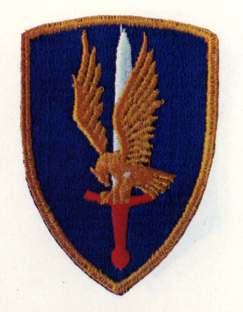 |
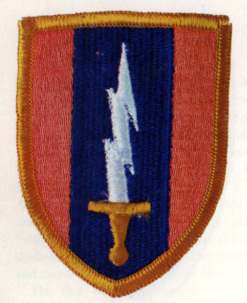 |
1st Signal Brigade From a satellite in orbit 18,000 miles above the Pacific Ocean to a couurier on a dusty Vietnamese road, the 1st Signal Brigade passes the word into, out of and within Southeast Asia. With more than 16,000 men scattered among more than 200 sites in the Republic of Vietnam and Thailand, the stratcom brigade is the largest combat signal unit ever formed and controls the most comprehensive military communications-electronics systems in the history of warfare. Its mission is very simply put: communications. Since its organization on April 1, 1966, the Brigade has fulfilled this mission by planning, engineering, installing, operating, and maintaining both the Southeast Asian portion of the Army's world wide strategic communications system and extensive area communications systems in South Vietnam and Thailand. All communications entering or leaving South Vietnam must pass through facilities operated by the Brigade, which consists of six subordinate signal groups, five in the Republic of Vietnam and one in Thailand. In the more than three years of its existance the 1st Signal team has provided communications of a scope never before achieved in a combat zone. The primary mission has been to "keep the shooters talking." However, during 1970, the Brigade instituted the "Buddies Together" program. Under this Vietnamization program ARVN soldiers are being trained to take over the highly sophisticated communications systems of the Brigade in South Vietnam. |
